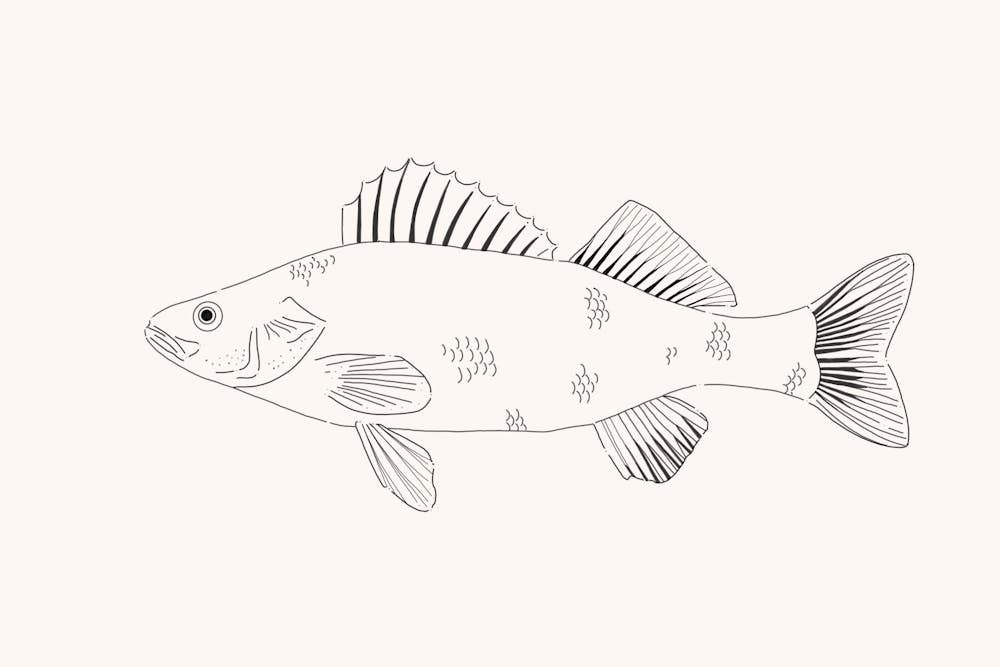Just underneath the surface of Lake Mendota lies one of the true hallmarks of Wisconsin culture: walleye.
Walleye are a freshwater fish prevalent in Midwestern rivers and lakes. In 2019, the Wisconsin Department of Natural Resources estimated that 21,302 adult walleye were present in Lake Mendota — around 2.2 fish per acre.
Named for their opaque “glassy” eye which helps them see in low-light conditions and sporting a spiny dorsal fin and sharp teeth, walleye have become a key player in Wisconsin society.
In ecological terms, a community is a group of species in a particular location that interact and coexist with one another. While many neglect to recognize humans as part of the local ecological community, their actions heavily affect the health of the ecosystem and the health of the ecosystem affects human social behavior.
That’s particularly true for walleye, a species vulnerable to climate change effects on freshwater ecosystems. But researchers and fish enthusiasts alike said they are dedicated to the protection and conservation of walleye across Wisconsin.
“This is a really important natural resource, so we want to do our best to conserve that and make sure that the next generation is able to utilize that as well,” said Quinn Smith, a doctoral student with the Center for Limnology.
Anthropogenic greenhouse gas emissions over the last century have contributed to devastating environmental effects and risk the demise of many local populations. The World Meteorological Organization (WMO), a subgroup of the United Nations, has been studying the changes in our climate for decades. It found the global mean near-surface temperature in 2023 to be about 1.4°C greater than the pre-20th century average. It also reported sea levels and ocean temperatures are rising.
Climate change can be seen in Wisconsin. Each year, the Wisconsin State Climatology Office documents the freeze-over and thaw dates of Lake Mendota. The 2023-24 winter recorded only 44 total days of ice cover, significantly lower than the average of 102 days.
These effects cause imminent danger to animal populations that rely on seasonal cues for reproduction and migration, such as walleye.
“They’re one of the first species to spawn. Usually that ice off is a really good indicator of when these fish are going to move into the shallows and spawn,” Smith said.
The possibility of more extreme seasonality threatens a walleye’s ability to properly breed, which may lead to a further declining population in coming years.
Throughout the year, walleye are generally found in cool water habitats. Warming waters create thermal stress which constitutes increased stress and energy use, Smith said.
Walleyes central to Wisconsin heritage
Effects on walleye in Wisconsin lakes don’t just affect populations in the water. Whether it be the conservation of the fish, recreation opportunities or indigenous practices, walleye are a central part of Wisconsin culture.
Many Indigenous tribes in the area have long-standing traditions related to spearfishing walleye and other local fish. Historically, this has led to clashes between Indigenous and non-Indigenous fishermen. Currently, tribes like the Bad River Band of Lake Superior Chippewa are some of the leaders in conservation of the water resources, including detailed management plans along with the operation of a large-scale walleye fish hatchery to keep numbers high in nearby rivers and lakes.
On top of its importance to Indigenous communities, walleye fishing is also known as a popular recreation opportunity for people across the state. One group reaping the social benefits of fishing is the Wisconsin Fishing Team.
“[Fishing is] just a good excuse to get together with friends and family and enjoy time outdoors and utilize the natural resources that we’ve been given,” said Joseph Trukowski, president of the Wisconsin Fishing Team.
“Coming from out of state… I didn’t know what to expect coming to Wisconsin about the fishing here. Seeing how big the community is and having a fishing team was definitely a good place for me to find my footing and where I want to be,” said Eli Weiser, Wisconsin Fishing Team community service coordinator.
While walleye fishing is popular during the summer months, it takes shape as a unique Wisconsin sport during the winter. Ice fishing keeps a sense of community alive, even through the coldest of days.
“I remember just growing up always being on the ice with my grandparents, and I think that’s common for a lot of Wisconsin families,” said Jeremy Kolasa, Wisconsin Fishing Team managing director.
Human-caused climate change has made it difficult for walleye to continue to thrive. To preserve walleye as a source of culture and community, researchers have focused on conservation and management techniques.
A current ecological study from Smith relates water climate to macrophytes, otherwise known as aquatic plants.
“Our macrophyte sites actually had a cooler water temperature compared to our non-macrophyte sites, and that difference was modeled to be right around 1.3 degrees Celsius cooler,” Smith said. “When it’s peak summer, if you're in a system where temperatures are kind of pushing up against that thermal maximum that these fish are comfortable with, that may actually represent a really important climate refuge.”
Macrophytes are a potential solution to keeping walleye cool. However, there are numerous other management practices currently being tested.
Escanaba Lake in Vilas County, Wisconsin is an experimental lake, according to the Wisconsin Department of Natural Resources. Researchers are able to test the effects that particular policies have on the prevalence of fish in the lake. These results are then used to determine what conservation and management strategies should be implemented in other Wisconsin lakes.






